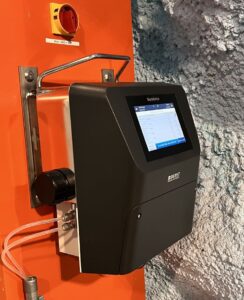At the foot of the emblematic Pierre Avoi Mountain in the Swiss Alps, the village of Saxon has a singular history with water. A spa town in the 1850s, it is an idyllic, natural setting, with its most of its drinking water (drawn from mountain springs) injected directly into the network without filtration or treatment.
Not so idyllic has been when residents of the 7,000 community (some in very remote areas) have fallen ill because of significant bacterial contamination. Only just recently in one of England’s most popular holiday destinations, Devon, cryptosporidiosis found in the supply from South West Water caused vomiting and diarrhoea, not to mention disruption, distress, anxiety and anger. Also in England, this has been closely followed by numerous people falling ill in Beckenham. Ongoing investigations are taking place by Thames Water to find out the cause – and then a warning in Surrey (also Thames Water) for people in the village of Bramley (600-people) not to drink tap water due to contamination.
Whether in the Swiss Alps, in an English tourist county or elsewhere, those responsible for water supply take action and apologise, but by then it is always too late.
Monitoring is in place of course, but gaining results from traditional methods of culturing bacteria can take up to 24 or even 48 hours. Culturing viruses can take weeks, so it is no wonder that contaminated water is distributed and consumed before illness from microbial hazards are reported.
But in forward-thinking Saxon, Switzerland, where maintaining the natural purity of their water is considered vital by its residents, there is now a new, automated system in place that will detect anomalies within 20 minutes. Yes, just 20 minutes – a system that will switch off the water and chlorinate, so that those drinking the water from their taps are always safe.
In England, South West Water blamed a faulty valve for all the issues. There was also talk that heavy agriculture was the reason. But in Saxon, the melting of ice was the culprit, and the problem that so many people now face in today’s fast-changing climate; prolonged, torrential rain.
‘Water industry trend towards automated and connected water monitoring solutions’

“We see a growing trend in the water industry towards automated and connected water monitoring solutions. However, microbial water quality is not usually surveyed because it is too time-consuming and too labour intensive. Rapid microbial methods are needed to address the problem properly, which is how we came to help Saxon with automated flow cytometry.”
A technology that provides rapid multi-parametric analysis of single cells in solution, Flow Cytometry utilizes lasers as light sources to produce both scattered and fluorescent light signals that are read by detectors.
In an average year, up to 70% of the water in Saxon and its mountain communities emanates from high-altitude springs. To protect people that live in the remote locations from contamination, carrying out urgent monitoring and manually cutting-off water supply, takes, not surprisingly, a large number of man-hours.
“It’s always the same story,” added Sara Ferdi. “There is always a lack of resources to get qualified personnel into the places where they are needed. This is why our BactoSense, an online flow cytometer, is such a game-changer for microbiological analysis because it can be connected to a SCADA system, or a GSM network via a small antenna
“There’s also the benefit that BactoSense functions with a sustainable, hermetically-sealed and refillable cartridge system, which not only allows you to run tests (depending on the sampling interval of 30 minutes up to 6 hours), so you don’t need to send anyone out to check it.”
By analysing real-time meteorological data supplied by MeteoSwiss (RainAlert) on a Cloud application, the BactoSense’s measurement intervals are set via PLC (programmable logic controller) and SCADA. In the event of poor quality, the water is automatically isolated, and an alarm is transmitted. Power consumption for the entire microbiological contamination risk management system is very low (just a few hundred watts).
From water catchment to distribution, everything for Saxon is now automated around the clock, swiftly addressing any anomalies; often without manual intervention.
“Compared to time-consuming heterotrophic plate counts (HPC) that are widely used to survey water quality, this is a real breakthrough,” continued Sara Ferdi from bNovate Technologies.
‘Managed Automatically’
“Since our automated analyser was introduced, there have been no reports from Saxon residents of illness due to water pollution. Several alerts have been triggered, with most contaminants traced to isolated sources. Actions such as chlorine dosing, reservoir isolation, alternative water supply activation, or reservoir inflow interruption can be initiated. Additionally, real-time alerts can be issued to individual villages in case of contamination risks. In response, all of the above-mentioned actions are managed automatically with minimal human intervention. Only 3.5 kg of chlorine were used over a year, whereas continuous dosing would have required around 129 kg of chlorine, thus supporting Saxon’s wish to maintain the purity of its natural water.”

Two months later, an anomaly saw an immediate need to isolate one spring and an inlet to avoid chlorination of a reservoir. Laboratory tests on the area downstream from the spring to the inlet revealed E. coli and Enterococcus spp. contamination. As a result of this pollution, the catchment was completely renovated.
In the autumn, contamination required a valve to be closed automatically, followed by temporary chlorination. Subsequent microbiological sampling showed an increase in mesophilic aerobic germs, E. coli and enterococci in the Vouarde spring. Thanks to the automatic measurements, the offending spring was isolated in time to protect consumers in the downstream networks.
Turbidity was chosen as the parameter of choice, and measurements taken were used to decide how best to implement the automatic discharge. With turbidity, bacterial contamination tends to be underestimated. This is to be expected for system-level measurements, but unexpected for raw water. The results of this study agree with previous results obtained with flow cytometry in a large study conducted by Besmer and Hammes in 2016. There, it was reported that sources are stable in dry weather and respond quickly to rain events. In addition, different online physical parameters showed responses to rain events, but different in terms of response time, sensitivity, and relative variation. They conclude that none of the individual abiotic parameters reliably describes total cell concentration. They concluded that total cell count is therefore a valuable parameter for microbiological impurities in karst springs. Monitoring provides an optimum understanding of the system and its processes. Turbidity cannot therefore reliably rule out microbiological contamination. Still, combined with automated flow cytometry, which offers fast, accurate and efficient cell detection, it is a very reliable way of automating source rejection.
‘Prevention is always best’
Sara Ferdi commented: “Combining real-time monitoring with proactive response mechanisms can ensure consistent access to safe drinking water, even amidst changing environmental dynamics.
“Prevention is always the best measure you can take. We have the technology now to stop people from becoming ill from water they rightly believe to be safe.
“Data-driven decisions from automated solutions can greatly improve drinking water safety at both small and much large water supply sites.”







